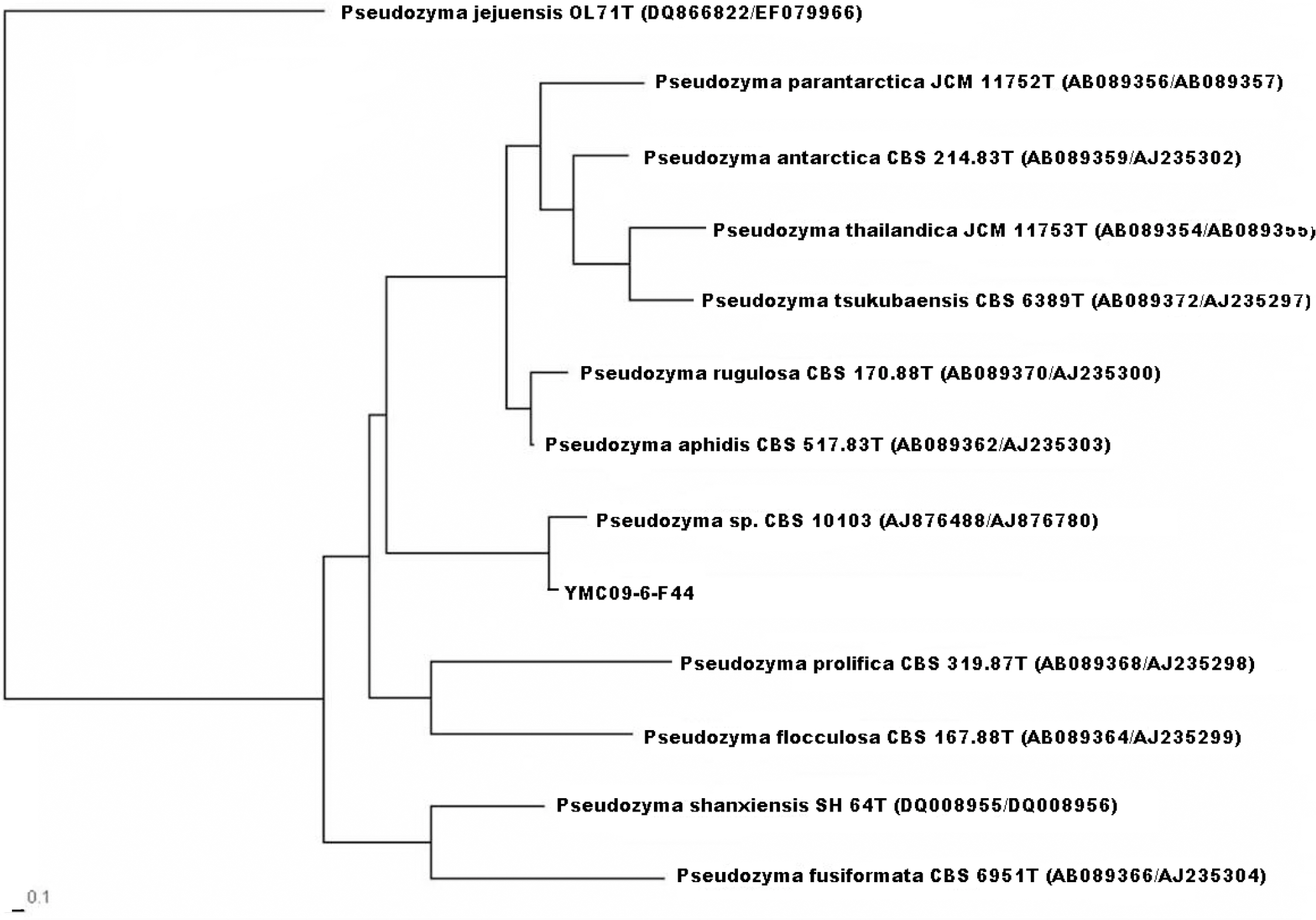Korean J Lab Med.
2010 Jun;30(3):284-288. 10.3343/kjlm.2010.30.3.284.
First Report of Brain Abscess Associated with Pseudozyma species in a Patient with Astrocytoma
- Affiliations
-
- 1Department of Laboratory Medicine, Yonsei University Wonju College of Medicine, Wonju, Korea.
- 2Department of Laboratory Medicine and Research Institute of Bacterial Resistance, Yonsei University College of Medicine, Seoul, Korea. deyong@yuhs.ac
- 3Department of Neurosurgery, Yonsei University College of Medicine, Seoul, Korea.
- KMID: 1781628
- DOI: http://doi.org/10.3343/kjlm.2010.30.3.284
Abstract
- A yeast-like strain was isolated from the brain abscess of a patient diagnosed with astrocytoma. Morphological and molecular analysis on D1/D2 domain in the 26S rRNA gene and internal transcript spacer region of the strain revealed that the strain belonged to the genus Pseudozyma. To the best of our knowledge, this is the first report on the isolation of a Pseudozyma strain from brain abscess.
MeSH Terms
Figure
Reference
-
1.Boekhout T., Fell JW. Pseudozyma Bandoni emend. Boekhout and a comparison with the yeast state of Ustilago maydis (de Candolle) Corda. Kurtzman CP, Fell JW, editors. The yeasts: a taxonomic study. 4th ed.Amsterdam: Elsevier Science Publishers;1998. p. 790–7.2.Sugita T., Takashima M., Poonwan N., Mekha N., Malaithao K., Thungmuthasawat B, et al. The first isolation of ustilaginomycetous anamorphic yeasts, Pseudozyma species, from patients' blood and a description of two new species: P. parantarctica and P. thailandica. Microbiol Immunol. 2003. 47:183–90.3.Lin SS., Pranikoff T., Smith SF., Brandt ME., Gilbert K., Palavecino EL, et al. Central venous catheter infection associated with Pseudozyma aphidis in a child with short gut syndrome. J Med Microbiol. 2008. 57:516–8.4.Fell JW., Boekhout T., Fonseca A., Scorzetti G., Statzell-Tallman A. Biodiversity and systematics of basidiomycetous yeasts as determined by large-subunit rDNA D1/D2 domain sequence analysis. Int J Syst Evol Microbiol. 2000. ;50 Pt. 3:1351–71.
Article5.Kurtzman CP., Robnett CJ. Identification of clinically important ascomycetous yeasts based on nucleotide divergence in the 5′ end of the large-subunit (26S) ribosomal DNA gene. J Clin Microbiol. 1997. 35:1216–23.
Article6.Thompson JD., Gibson TJ., Plewniak F., Jeanmougin F., Higgins DG. The CLUSTAL_X windows interface: flexible strategies for multiple sequence alignment aided by quality analysis tools. Nucleic Acids Res. 1997. 25:4876–82.
Article7.Saitou N., Nei M. The neighbor-joining method: a new method for reconstructing phylogenetic trees. Mol Biol Evol. 1987. 4:406–25.8.Felsenstein J. Confidence limits on phylogenies: an approach using the bootstrap. Evolution. 1985. 39:783–91.
Article9.Bandoni RJ. On an undescribed, pleomorphic hyphomycete from litter. Bot J Linn Soc. 1985. 91:37–43.
Article10.Wei YH., Lee FL., Hsu WH., Chen SR., Chen CC., Wen CY, et al. Pseudozyma antarctica in Taiwan: a description based on morphological, physiological and molecular characteristics. Bot Bull Acad Sin. 2005. 46:223–9.11.Wang QM., Jia JH., Bai FY. Pseudozyma hubeiensis sp. nov. and Pseudozyma shanxiensis sp. nov., novel ustilaginomycetous anamorphic yeast species from plant leaves. Int J Syst Evol Microbiol. 2006. 56:289–93.12.Boekhout T., Fell JW., O'Donnell K. Molecular systematics of some yeast-like anamorphs belonging to the Ustilaginales and Tilletiales. Stud Mycol. 1995. 38:175–83.13.Boekhout T., Bandoni RJ., Fell JW., Kwon-Chung KJ. Discussion of teleomorphic and anamorphic genera of heterobasidiomycetous yeasts. Kurtzman CP, Fell JW, editors. The yeasts: a taxonomic study. 4th ed.Amsterdam: Elsevier Science Publishers;1998. p. 609–25.
Article14.Golubev VI. Mycocinogeny in smut yeast-like fungi of the genus Pseudozyma. Mikrobiologiia. 2007. 76:813–6.15.Mimee B., Labbe C., Pelletier R., Belanger RR. Antifungal activity of flocculosin, a novel glycolipid isolated from Pseudozyma flocculosa. Antimicrob Agents Chemother. 2005. 49:1597–9.16.Kitamoto D., Isoda H., Nakahara T. Functions and potential applications of glycolipid biosurfactants—from energy-saving materials to gene delivery carriers. J Biosci Bioeng. 2002. 94:187–201.17.Petti CA; Clinical and Laboratory Standards Institute. Interpretive criteria for identification of bacteria and fungi by DNA target sequencing: approved guideline. Document MM18-A. Wayne, PA: Clinical and Laboratory Standards Institute;2008. p. 54–5.



